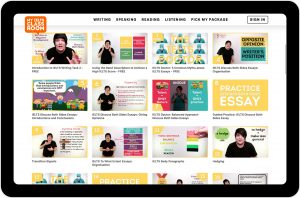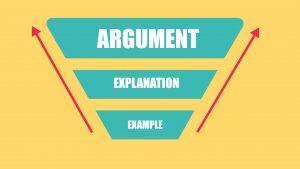
How can you think of ideas for your IELTS essay?
So, you are sitting in the exam room feeling confident. You have prepared well. You know how to organise all the possible types of essay. You can use distancing, and referencing, and hedging. Your use of transition signals is superb. Everything is good in the world.
But then, the exam starts, you open the question booklet, read the task and……………….Nothing 😯…………… You don’t have a single idea 🙄………. Not one 💀……… Your head is totally empty 🤔 ………………….. There’s just you, the question, and a growing sense of panic.😱
What do you do? How can you brainstorm ideas for your IELTS essay when inspiration fails you? 😰
Well, I think that this is every student’s worst nightmare. And, even though I can’t give you specific ideas to use on your exam day (because I don’t know what question you will get!), what I can do is show you three techniques that can help you come up with ideas for any IELTS essay.
So, to start, let’s quickly think about what makes a GOOD IDEA. I mean, you have to know what you are looking for before you start searching!
Good ideas for IELTS essays …
- directly address the exam question. The more focussed your idea is on the topic of the exam, the better. Therefore, it’s essential that you check each of your ideas against the task to make sure the they are relevant and on point. The last thing you want to do is write an essay that is off-topic.
- can be expanded. This is really important! We will only need between 2 – 4 ideas for our essay. But the ideas themselves are not really what get us the points – it’s how we expand them. You will need to be able to write between 2 and 5 sentences for each idea. If you look at your idea and can’t think if a way to describe it in more detail – you can’t use it. One sentence arguments are actually damaging for you TR score, so if an idea can’t be developed, it can’t be used.
- are relatively simple. Here’s the thing, you are writing an essay in ENGLISH, not your native language. For most test-takers, this means that the arguments they give will NOT be as sophisticated as the ones they could offer in their own tongue. That’s OK, but you need to remember this and be realistic about what you can write. Complex arguments that require subtlety in meaning often end badly in the IELTS exam because most students simply don’t have the grammar or vocabulary to argue them clearly. I find that a simple idea that is argued using complex sentences is the best combination. IELTS examiners don’t expect you to solve a difficult social problem in 40 minutes in 250 words! All they want to see are clear arguments that are connected to the question and expanded well!
- are persuasive. There is a persistent myth about the IELTS exam that says “your ideas don’t matter” – THIS IS NOT TRUE. Your opinion doesn’t matter (you are free to agree, disagree, or even partly agree and disagree – there is no “correct” answer”), but the quality of your arguments DO. You want the examiner to be nodding as they read your essay. You want the examiner to be thinking “YES! These ideas support the test-taker’s position well”. One of my students told me recently in an essay that living in another country when you don’t speak the language is difficult because you can’t choose the flavour of donuts you want very easily!!!! Is this idea connected to the question? Yes! Is it persuasive? No!!! (Trust me, I have lived abroad for many years, and donuts are the least of my problems). If you want a 6.0 or 6.5, an argument like this might be OK, but if you want a 7.0 or 7.5, you will have to think of ideas that are more convincing than donuts! 🍩 Remember, the Band 8 Descriptors say: presents a well-deveoped response to the question with relevant, extended and supported ideas. Relevant!
So, now we know what good ideas are – how do we find them?! 🔎 Well, I want to show you three techniques that I find useful (Yes! Even I find it hard to come up with ideas sometimes!): The Bottom-Up Approach, The Top-Down Approach, and The Simplify the Question Approach. Let’s go through each of them together.
Click here to watch the first three lessons in our IELTS Writing Course to see the difference that genuine expertise can make to your preparation.

The Bottom-Up Approach to Brainstorming Ideas for Essays☝
So, I have found that for difficult questions, students might not be able to form a full idea immediately, but they are able to give a simple example of a phenomenon. In the bottom-up approach, we are going to take this example, and work backwards to come up with a relevant argument. For example, I often use this question in class:
Men and women are capable of doing all jobs equally well.
To what extent do you agree or disagree?
And when students see this question for the first time, they often immediately say that they disagree. But when I ask why, they can only come up with arguments like construction work or primary-school teachers. Now, these are actually good examples. But, that’s all they are – examples. You can’t start your essay with a sentence like this:
XX The first reason why men and women are suited to different jobs is construction work. XX
However, what we can do is use these examples to work back to the idea. Think about it – examples usually come after explanations, and explanations come after IDEAS!

So, all we need to do, is ask ourselves some simple questions to find out what our particular example is an example of! If we take the example “construction work”, we might ask ourselves these questions:
What does construction work show us? Men are generally stronger than women.
OK, so why does that mean men and women can’t so the same job? They have different physical attributes.
💥 BOOM – WE HAVE AN IDEA 💥
✅✅ The first reason men and women are suited to different jobs is that they have different physical attributes.✅✅
And, even though I totally disagree with this argument, the fact that it doesn’t match my opinion isn’t important! Remember, all the examiner cares about is that you can offer a relevant idea and defend it! Is this idea relevant? Yes! Can I expand it? Yes (I already have my example!) Is it relatively simple to explain? Yes! Then, it’s a good idea!
I love the the the bottom-up method. With practice it can take literally 10 or 15 seconds to move from an example back to a great idea. And, as I just said, you know that the ideas you come up with using it are expandable because you already have your example to support your argument!
So, the if the Bottom-Up approach is starting with an example and moving backwards, can you guess what the Top-Down approach is?
The Top-Down Approach to Brainstorming ideas for your IELTS Essay 👇
Yes, sometimes when we see an exam question, we come up with a vague idea that holds the seed of a good argument, but needs to be explored more fully to reveal it. Or, in other words, we need to dig down deeper to find the idea. Again, let’s look at an exam task:
What are the advantages and disadvantages of school uniforms?
OK, so let’s imagine that this time when you look at the question, your brain doesn’t immediately give you an example, but instead it gives you the words: the same. Now, these BIG, GENERAL WORDS contain the seed of a good idea, but right now the concept the same is TOO BIG. You can’t start your essay with a sentence like this:
XX One good thing about school uniforms is that everybody is the same. XX
What exactly does it mean that everybody is the same? They have the same ideas? The same education? The same upbringing? It’s not clear from the two words because they are too general. So, in the top-down approach, we narrow down vague ideas more to make them more specific.

How do we do that? Well, again, we ask ourselves some quick, simple questions. For the top-down approach, you will find the question words How and Why very useful:
What is good about school uniforms? Everybody is the same.
Why is it an advantage that everybody is the same? It creates equality in the classroom.
How? People are judged on their performance, not their appearance.
💥 BOOM – WE HAVE A TOPIC SENTENCE! 💥
✅✅ One argument in favour of uniforms is that they create equality in classrooms by allowing students to be judged on their performance, not their appearance. ✅✅
The great thing about the the top-down approach is that all you need to do to move from a vague idea to a more specific one is ask yourself one question. But remember, this time you will need to check that you can extend your idea well. If you have nothing more to say about the idea once you’ve narrowed it down, throw it away and look for a new one!
Now, I love both the bottom-up and top-down approaches, but they do rely on you having at least the beginning of a idea – either one that is too specific, or one that this too vague. But, what happens if you have absolutely NO idea? Well, in that case, we have to turn to our third and final technique – The Simplify the Question Approach.
The Simplify The IELTS Question Approach
Very often, IELTS questions are about social issues or current trends, which can be complex for students to understand. Plus, tasks can be worded in an academic way, which just adds to the confusion. In the Simplify the Question Approach, we are going to take the question and reword it into everyday language to help trigger ideas.
🛑 🛑 WARNING: IT IS ESSENTIAL IN THIS APPROACH THAT YOU DO NOT CHANGE THE TOPIC OF THE QUESTION 🛑🛑
Seriously, if you use this approach, you must not change the topic of the question. Remember, we have to always directly address the question given to us. If you change the topic, you can kiss goodbye to a good TR score. But, that said, often it is possible to quickly rephrase a question in a way that makes it easier to comprehend. In particular, a complicated question can often be turned into a much simpler Yes/No question. For example, imagine you were given this task in the exam:
In many places, new homes are needed but the only space available for building them is in the countryside. Some people believe that it is more important to protect the countryside and not build new homes there.
What is your opinion about this?
To make this long task more manageable in your mind, you might simply ask yourself:
Should we build new homes in the countryside? Yes
This yes/no question is a much easier for most students to comprehend. Then, once you have decided yes or no, all you have to do is follow this first question with WHY?!
Should we build new homes in the countryside? Yes
Why? We have to provide affordable housing, and that requires new-build properties on the outskirts of cities.
Why is actually my favourite question for finding arguments. The human brain is wired to be curious, and turning a complex question into a why question can magically create ideas where there weren’t any before! (In fact, I have a theory that this is reason that student like problem/solution questions – they usually always contain the question why!)
Actually, you can use why to find ideas for all sorts of questions. Take this advantages and disadvantages question. At first it looks pretty tricky:
Today, more and more tourists are visiting places where conditions are difficult, such as the Sahara desert or the Antarctic.
What are the benefits and disadvantages for tourists who visit such places?
But, if we ask ourselves a why question:
Why do people travel to extreme places like the Sahara or the Antarctic?
💥 BOOM – SUDDENLY MY BRAIN EXPLODES WITH IDEAS 💥
They are seeking adventure. It’s human nature to explore. They want to test their physical limits.
And, these are clearly the advantages. How do we discover the disadvantages, we simply ask Why not?
Why DON’T people travel to extreme places like the Sahara or the Antarctic?
💥 BOOM💥
It’s expensive. It requires physical endurance. It can be life-threatening.
Again, I am not changing the topic of the question, just the way that the question is being asked – sometimes making a simple yes/no question, or asking why can be enough to trigger previously hidden ideas!
Now, if you have finished this blog post and are still worried that you won’t have any ideas on exam day, the truth is that you simply have to become more accustomed to the topics that IELTS essays focus on.
The good news is that there are limited number of topics that the question writers can use. Think about it. They have to choose a topic that is non-emotional (no politics, religion, ethics or sex). They have to choose a topic that will be recognised by EVERY CULTURE in the world (so no Brexit!). And, they have to choose a topic that will be equally as appealing to different age groups (so no complex work questions!) It’s not an easy task! That’s why the same topics come around again and again and again.
Common IELTS Writing Topics
The environment, sport, languages, social trends, crime, gender, housing, advertising, travel, education work, communication, young v old generation, modern lifestyles, the arts and culture, money, urban life, the environment, consumerism, etc, etc, etc
So, if you are struggling for ideas, then start reading about these topics. Or buy a good IELTS vocabulary book that is based on them. Or read the 50+ model essays in my TASK 2 course that cover the most common ones.
But, however you do it, remember that IELTS tests your level of English and your Academic skills. Having ideas or arguments for these topics is one of those skills, so you should invest as much time into this as you do in for the other parts of the exam. As I said at the beginning, there’s no point having excellent language skills if you don’t have anything to write about!
Three Three Ways to Brainstorm Ideas for your IELTS essay
- Think of an example first and then work back up to the general idea by asking what this example shows (the bottom-up approach)
- Think of the most general answer you can and then ask yourself questions to make your idea more specific (the top-down approach)
- Try to rephrase the IELTS question in a more simple way so your brain can process it more easily (The simplify the question approach)
OK, I hope that this lesson helped. The truth is that finding ideas for your IELTS essay is a skill that definitely improves with practice. If you complete my Task 2 Video Course, you will write more than 50 essays on the most common exam topics. By the time you have come up with ideas for all of those, you should be prepared for any question on exam day! 🚀
